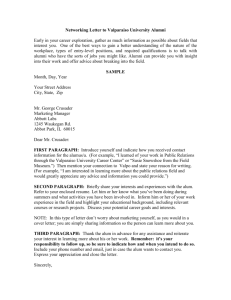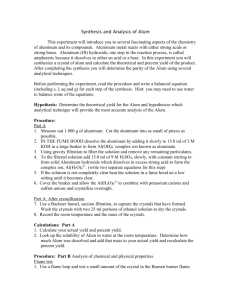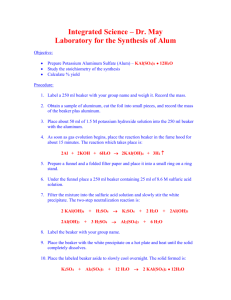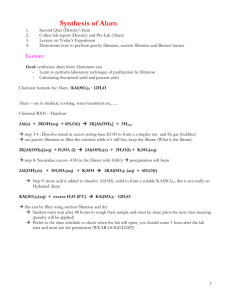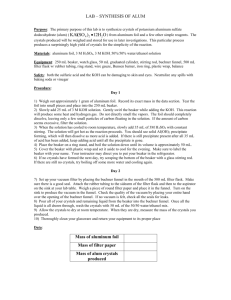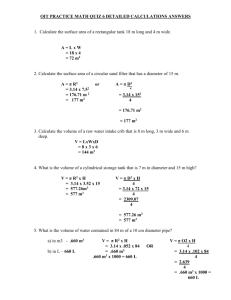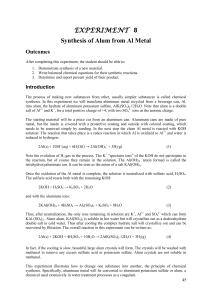Chemistry 132.L10. Recycling Your Can:Making Alum
advertisement
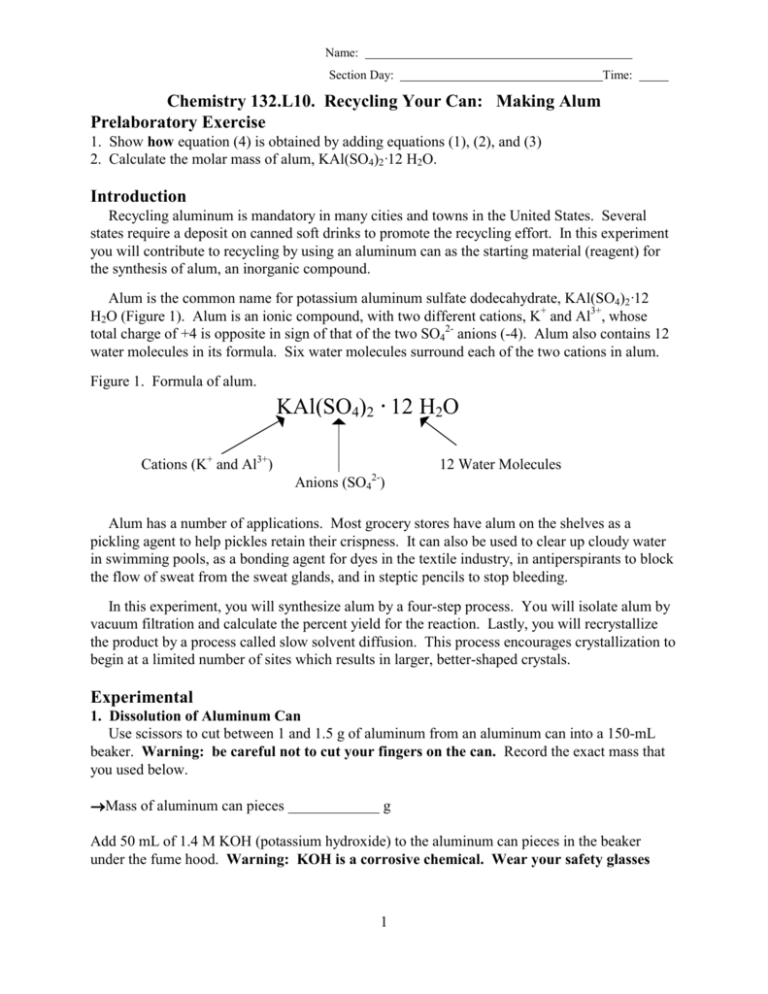
Name: Time: Section Day: Chemistry 132.L10. Recycling Your Can: Making Alum Prelaboratory Exercise 1. Show how equation (4) is obtained by adding equations (1), (2), and (3) 2. Calculate the molar mass of alum, KAl(SO4)2·12 H2O. Introduction Recycling aluminum is mandatory in many cities and towns in the United States. Several states require a deposit on canned soft drinks to promote the recycling effort. In this experiment you will contribute to recycling by using an aluminum can as the starting material (reagent) for the synthesis of alum, an inorganic compound. Alum is the common name for potassium aluminum sulfate dodecahydrate, KAl(SO4)2·12 H2O (Figure 1). Alum is an ionic compound, with two different cations, K+ and Al3+, whose total charge of +4 is opposite in sign of that of the two SO42- anions (-4). Alum also contains 12 water molecules in its formula. Six water molecules surround each of the two cations in alum. Figure 1. Formula of alum. KAl(SO4)2 · 12 H2O Cations (K+ and Al3+) 12 Water Molecules 2- Anions (SO4 ) Alum has a number of applications. Most grocery stores have alum on the shelves as a pickling agent to help pickles retain their crispness. It can also be used to clear up cloudy water in swimming pools, as a bonding agent for dyes in the textile industry, in antiperspirants to block the flow of sweat from the sweat glands, and in steptic pencils to stop bleeding. In this experiment, you will synthesize alum by a four-step process. You will isolate alum by vacuum filtration and calculate the percent yield for the reaction. Lastly, you will recrystallize the product by a process called slow solvent diffusion. This process encourages crystallization to begin at a limited number of sites which results in larger, better-shaped crystals. Experimental 1. Dissolution of Aluminum Can Use scissors to cut between 1 and 1.5 g of aluminum from an aluminum can into a 150-mL beaker. Warning: be careful not to cut your fingers on the can. Record the exact mass that you used below. →Mass of aluminum can pieces g Add 50 mL of 1.4 M KOH (potassium hydroxide) to the aluminum can pieces in the beaker under the fume hood. Warning: KOH is a corrosive chemical. Wear your safety glasses 1 and avoid contact with your skin. Gently heat the solution under the hood, stirring with a glass rod. Continue heating until all of the aluminum is completely reacted. The reaction for this process is: 2 Al(s) + 2 KOH(aq) + 6 H2O(l) → 2 KAl(OH)4(aq) + 3 H2(g) (1) Allow the solution to cool for a few minutes. Gravity filter the solution into a second 150 mL beaker to remove the paint and other impurities. Throw the filter paper away in the garbage. 2. Formation of Aluminum Hydroxide While stirring with your glass rod, slowly and carefully add 30 mL of 6 M H2SO4 (sulfuric acid). Warning: H2SO4 is a corrosive chemical. Wear safety goggles and avoid contact with your skin. In addition, H2SO4 and KOH react violently with each other. Add slowly and carefully. A white precipitate (Al(OH)3(s)) should form during the addition process. The reaction is: 2 KAl(OH)4(aq) + H2SO4 (aq) → 2 Al(OH)3(s) + K2SO4(aq) + 2 H2O(l) (2) 3. Formation of Alum Gently heat the mixture. Allow it to boil gently (reflux) for five minutes and cool five minutes. If all of the solid did not dissolve, gravity filter the solution into a third 150 mL beaker. Place the beaker containing the solution into an ice bath for 20 minutes. Stir occasionally with a clean stirring rod. White crystals of alum will form at the bottom of the beaker. The reaction is: 2 Al(OH)3(s) + 3 H2SO4 (aq) + K2SO4(aq) + 18 H2O(l) → 2 KAl(SO4)2 · 12 H2O(s) (3) 4. Vacuum Filtration of Alum While your alum is crystallizing, set up a vacuum filtration device as shown below using a side-armed flask, a filtervac, a Büchner funnel, and a piece of filter paper. Place the filter paper in the funnel, and the funnel in the filtervac and the side-armed flask. Figure 2. Vacuum filtration set-up. Filter paper Büchner funnel Filtervac Connected by tubing to a water aspirator Side-armed flask 2 Connect the side-arm of the flask to a water aspirator and turn on the water. Carefully pour the alum crystals through the filter paper, maintaining downward pressure on the Büchner funnel to maintain the vacuum. Use a rubber policeman to quantitatively transfer your crystals to the filter paper. Maintain the vacuum on the crystals for 5 minutes, then remove the tubing from the side arm flask and turn off the water. Weigh a clean, dry 50 mL beaker and record the value below. Transfer your crystals to the 50 mL and label the beaker with your name, lab section, and lab time. Cover the beaker, and allow the crystals to dry until next week in a location designated by your instructor. →Mass of 50 mL beaker →Mass of beaker plus dried Alum crystals (week 2) →Mass of Alum crystals g g g 5. Week two Determine the mass of alum produced last week and record the value. You can now complete the % yield calculation. Dispose of your alum in an alum waste bottle. Calculations The overall balanced equation for the synthesis of alum may be obtained by adding equations (1), (2), and (3) to obtain 2 Al(s) + 2 KOH(aq) + 4 H2SO4 (aq) + 22 H2O(l) → 2 KAl(SO4)2·12 H2O(s) + 3 H2(g) (4) Use equation (4) and the mass of aluminum can you used to calculate the following, showing your work. Remember, you calculate the moles of aluminum from the mass of aluminum using its molar mass. The moles of alum (theoretical) are calculated from the stoichiometry of equation (4). The mass of alum (theoretical) is calculated using the molar mass of alum. The actual mass of alum is the amount that you obtained on the filter paper. The percent yield equation is shown below. Refer to your text book if you need help with these calculations. % yield = actual yield × 100 theoretical yield Moles of aluminum moles Moles of alum (theoretical) moles 3 Mass of alum (theoretical) g Mass of alum (actual) g Percent yield of alum % Questions 1. How many grams of H2 gas were produced, assuming that the aluminum metal (Al(s)) reacted completely? 2. Presumably your percent yield was not 100 %. In what steps of the procedure do you think you may have lost some product? Where did the product go? 4

